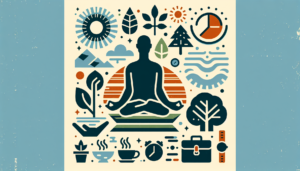Finding Calm in Nature: A Journey Within
Finding Calm in Nature: A Journey Within
The Science of Nature’s Calming Effects
The relationship between nature and mental health is increasingly recognized within psychological and scientific communities. Research has consistently demonstrated that natural environments can significantly reduce stress, anxiety, and depression. According to the Psychological Bulletin, exposure to nature boosts our mood and evokes feelings of tranquility. A study by the University of Exeter even found that individuals living in greener urban areas report higher wellbeing.
Nature therapy—often referred to as ecotherapy—utilizes the calming effects of nature to promote emotional and psychological health. Engaging with natural environments stimulates the parasympathetic nervous system, which induces relaxation and lowers the body’s stress response. Activities like walking in a forest or sitting by a lake activate our senses and attune us to the present moment, fostering mindfulness and a profound sense of calm.
The Healing Power of Green Spaces
Urbanization has led to a retreat from natural environments, with studies indicating that access to parks and natural areas can alleviate stress and improve overall mental health. The presence of greenery has multifaceted benefits; it bridges the gap between urban life and the restorative power of nature.
Biophilia Hypothesis
The biophilia hypothesis posits that humans have an innate connection with nature. Edward O. Wilson, who coined the term, suggested that our relationship with the natural world is essential for psychological well-being. Substantial evidence supports this, indicative of the therapeutic qualities of nature and our psychological responses to natural environments.
Nature’s Influence on Cognitive Functioning
Nature not only affects emotional health but cognitive functioning as well. A study conducted by researchers at the University of Utah found that spending time in nature can significantly enhance creative problem-solving abilities. Participants who engaged in activities like hiking reported a 50% improvement in creativity, reaffirming the idea that disconnecting from technology and immersing ourselves in nature promotes clearer thinking and innovative ideas.
Immersive Nature Experiences
Visiting natural environments can take many forms, each offering distinct benefits for mental health and well-being. Here are several immersive experiences that enhance the journey within:
Forest Bathing (Shinrin-yoku)
Originating in Japan, forest bathing is the practice of taking in the forest atmosphere through our senses. Research shows that forest bathing can lower cortisol levels (a primary stress hormone), improve mood, and even bolster immune function. Participants are encouraged to walk slowly, observe their surroundings, and breathe deeply, engaging fully with the present moment.
Beach Walks and Shoreline Meditation
The rhythmic sound of ocean waves has a meditative quality that can calm the mind. Beach walks stimulate all five senses; the tang of salt in the air, the sound of crashing waves, and the feeling of sand beneath one’s feet can create an immersive experience. Shoreline meditation involves finding a quiet spot where one can sit peacefully, using the ocean’s tranquility to guide a meditative practice, fostering a deep sense of peace and reflection.
Mountaineering and Hiking
Engaging in physical activity amid stunning vistas can be profoundly rejuvenating. Hiking not only aids physical health but the challenge of summiting peaks promotes a sense of achievement. The exertion necessary to navigate trails can release endorphins, elevating mood while fostering a connection with the vastness of nature.
Gardening and Nature-Based Creativity
Gardening provides a direct link to the earth, linking the act of nurturing plants with personal growth. Studies indicate that hands-on activities like gardening can reduce symptoms of anxiety and depression. Furthermore, creative pursuits—drawing landscapes, journaling outdoor reflections, or photography—enhance our connection to nature and serve as tools for self-reflection.
The Role of Mindfulness in Nature
Mindfulness is the practice of maintaining a moment-to-moment awareness of thoughts, feelings, bodily sensations, and surrounding environments. When combined with nature experiences, mindfulness practices can deepen the connection to the present, allowing individuals to engage fully with their surroundings.
Mindful Walking
Mindful walking in nature encourages individuals to pay attention to the sensation of their feet on the ground, the sounds of rustling leaves, and the sights of blooming flowers. This form of meditation creates a powerful anchor, facilitating a smoother connection to one’s thoughts and emotions.
Nature Journaling
Keeping a nature journal fosters reflective practice, allowing individuals to document their emotions and experiences in natural settings. Writing about encounters with wildlife, feelings elicited by certain environments, or simply sketching a scene can deepen one’s awareness and appreciation of both nature and self.
Guided Nature Meditation
Guided meditations set in nature, whether through an audio track or leading oneself through visualization, can enhance relaxation and presence. These meditations often encourage participants to imagine the sights, sounds, and textures of the environment, cultivating a stronger bond with both nature and inner peace.
Experiencing Nature Through the Seasons
Nature’s offerings change with the seasons, and each transition invites distinct experiences that can help in finding calm.
Spring Awakening
Spring symbolizes renewal and growth. Observing budding flowers and the return of wildlife can invigorate the spirit. Spending time outdoors during spring promotes a sense of new beginnings, enhancing optimism and emotional buoyancy.
Summer’s Embrace
The warmth of summer allows for exploration. Engaging in outdoor activities like picnicking, swimming, or stargazing can facilitate joyous experiences that enhance social connections, leading to increased happiness and overall well-being.
Autumn Reflection
As leaves turn vibrant colors and trees prepare for dormancy, autumn provides a space for reflection. Nature’s transformation can mirror personal growth journeys, making it an ideal season for introspection, nurturing a sense of gratitude for nature’s cyclical beauty.
Winter Serenity
Winter’s stark landscapes can be strikingly peaceful. The quiet blanket of snow dulls overwhelming stimuli, creating an ideal backdrop for self-reflection and grounding practices. Embracing the cold through activities like snowshoeing or simply walking in a serene park can rejuvenate one’s spirit.
Nature-Based Community Engagement
Fostering connections with individuals who share a love of nature can amplify its calming effects. Community gardening, nature walks, or birdwatching clubs create a sense of belonging, fortifying mental health and encourage collaboration with others who prioritize emotional well-being through nature.
Nature-based community activities promote social support, which is crucial for mental health. Sharing experiences and knowledge associated with natural environments can cultivate deep bonds, promoting resilience and collective wellbeing.
Conclusion
Nature remains a powerful ally in our pursuit of calm and mental clarity. Engaging with the outside world offers us a respite from the challenges of daily life, serving as a bridge to our most intrinsic selves. Embracing nature—whether through tranquil walks or engaging in mindful practices—creates spaces for healing, introspection, and connection, making the journey within a profound experience worth exploring.








